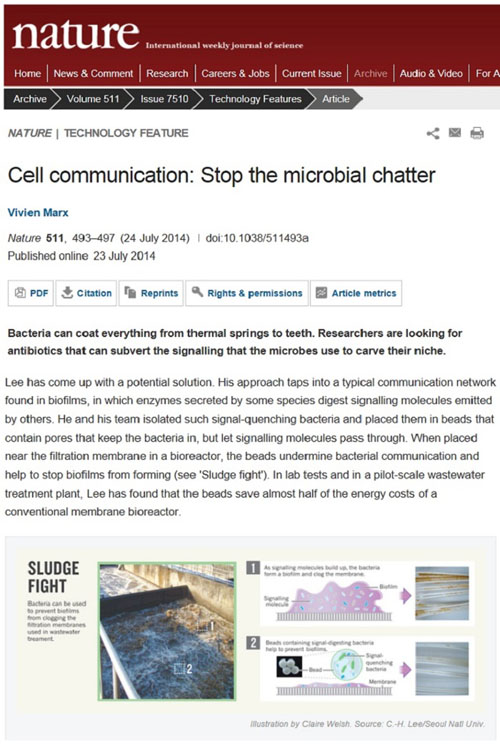-
 Korea.net's 24-hour YouTube channel
Korea.net's 24-hour YouTube channel- NEWS FOCUS
- ABOUT KOREA
- EVENTS
- RESOURCES
- GOVERNMENT
- ABOUT US
A domestic research team has made a breakthrough in helping prevent “biofouling” in water treatment plants.
According to the Korea Environmental Industry & Technology Institute (KEITI), a research team led by Professor Lee Chung-hak, a chemical engineer at Seoul National University, recently created a technology that can stave off membrane fouling, a chronic headache in the process of treating wastewater, a first in the world.
A membrane bioreactor (MBR) is an advanced wastewater treatment technology used worldwide that makes the treated water reusable. However, the system has a chronic issue: the formation of biofilms, slimy mats of bacteria that spread across the surface of the water filters.
To deal with the problem, biofilms have so far been physically cleaned off or else harsh chemicals were used. Moreover, the method is quite costly, enough to make up about 60 percent of the total cost of operating an MBR.

Lee and his team have come up with a solution to that. The scientists found that there is a typical network of communication between biofilms, in which enzymes secreted by some species digest the signaling molecules emitted by others.
The team isolated such “signal-quenching” bacteria and placed them in beads that contain pores that keep in the bacteria, but let through the signaling molecules. The beads undermine bacterial communication and help to stop biofilms from forming. More importantly, the method can save almost half the cost of a conventional membrane bioreactor.
The results were brought to light in the July 24 article “Cell communication: Stop the microbial chatter,” published in Nature, the world’s most prominent scientific journal. The team has applied for a patent on the technology in the U.S., Japan, Europe and China.
By Sohn JiAe
Korea.net Staff Writer
jiae5853@korea.kr
According to the Korea Environmental Industry & Technology Institute (KEITI), a research team led by Professor Lee Chung-hak, a chemical engineer at Seoul National University, recently created a technology that can stave off membrane fouling, a chronic headache in the process of treating wastewater, a first in the world.
A membrane bioreactor (MBR) is an advanced wastewater treatment technology used worldwide that makes the treated water reusable. However, the system has a chronic issue: the formation of biofilms, slimy mats of bacteria that spread across the surface of the water filters.
To deal with the problem, biofilms have so far been physically cleaned off or else harsh chemicals were used. Moreover, the method is quite costly, enough to make up about 60 percent of the total cost of operating an MBR.

“Cell communication: Stop the microbial chatter” is published on July 24 in Nature, the world’s most prominent scientific journal.
Lee and his team have come up with a solution to that. The scientists found that there is a typical network of communication between biofilms, in which enzymes secreted by some species digest the signaling molecules emitted by others.
The team isolated such “signal-quenching” bacteria and placed them in beads that contain pores that keep in the bacteria, but let through the signaling molecules. The beads undermine bacterial communication and help to stop biofilms from forming. More importantly, the method can save almost half the cost of a conventional membrane bioreactor.
The results were brought to light in the July 24 article “Cell communication: Stop the microbial chatter,” published in Nature, the world’s most prominent scientific journal. The team has applied for a patent on the technology in the U.S., Japan, Europe and China.
By Sohn JiAe
Korea.net Staff Writer
jiae5853@korea.kr
Most popular
- First hearing-impaired K-pop act hopes for 'barrier-free world'
- Event 'K-Beauty Hang Out' draws hundreds in Philippines
- Ceremony in Seoul inducts 2,641 content creators of Korean culture
- 'Mad Max' director impressed by 'cinema-literate' Korean viewers
- Cultural spring festival Seoul Festa to start on May 1













